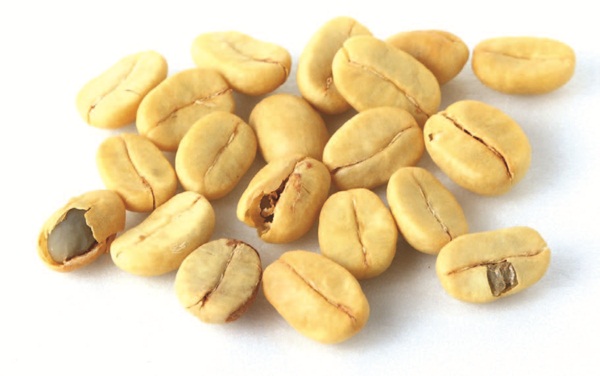The evolution of coffee treatment: water washing, sun exposure and mixed treatment of coffee

Today, we are going to talk about the way coffee is handled.
With the development of coffee today, the treatment of raw beans is mainly divided into water washing, sun exposure and the combination of the first two. Honey treatment belongs to the latter.
To talk about honey treatment, we have to start from the coffee structure and the two oldest treatments-washing and tanning.
Coffee cherry structure

From outside to inside:
Pulp: the peel and pulp of coffee cherry
Mucilage: pectin, gum. Found in most fruits, not just coffee cherries
Parchment: coffee endocarp, color similar to parchment, just like rice also has a layer of husk. Play a role in protecting raw beans
Silverskin: silver leather. A thin coat that falls off most of the coffee when it is roasted
What is washing:
When coffee cherries are picked from trees, they are usually placed in a pool full of water for branches, leaves and density screening: overripe and undermature coffee cherries float to the surface because they are not dense enough, and coffee fruits that are ripe enough will sink to the bottom of the pool.
Then enter the peeling and pulp machine to remove the outermost layer of peel and pulp. At this time, the coffee enters the fermentation stage with residual pulp and pectin. The mode and duration of fermentation varies from region to region depending on the local climate: Latin America ferments for 12-36 hours in a pool full of water and under the action of microbes, while Kenya's usual practice is to let pectin coffee react naturally with microbes in the air to remove the gum.
Once the fermentation is complete, the coffee with the endocarp enters the flushing channel and is washed away by a large amount of water.
Clean coffee with endocarp enters the drying process, and at this stage, there are a variety of drying methods: direct sunlight, combination of sun drying and machine drying, combination of shade drying and sun drying, and so on. It usually takes 10 days to a month to keep the moisture content stable at around 12%.
After all the above steps are completed, the coffee with endocarp will be placed in a sack and left in place for 2-3 months, often referred to as raw beans in Latin America, making the quality of the coffee more stable.
Finally, the coffee is shelled, the endocarp that protects the raw coffee beans is removed, repackaged, exported and sold.
The general characteristics of washed coffee: clean, bright, sweet and sour, medium mellow thickness; tend to apple, lemon and berry acidity, milk and sweet chocolate, caramel, nut flavor.
It is common in Central America, South America, Africa and a small part of Indonesian coffee.
In addition, the washing treatment method is a waste of water, so it is usually the producing area rich in water resources that will choose this treatment method.

What is the sun:
Tanning has long existed in Ethiopia and Yemen. It doesn't waste much water and electricity, but it takes a lot of time and manpower to separate unripe beans from defective beans.
After the coffee is picked, immediately go into the drying ground to dry. This process takes up to a month and must be carefully observed and constantly turned to prevent excessive fermentation, spoilage and uneven drying.
Of course, it can also be dried in an African bed (a grid that isolates the ground). The advantage is to make the coffee dry more evenly and avoid spoilage.
After drying, the coffee cherry enters the process of desiccating peel, flesh, endocarp and so on.
The benefits of tanned coffee: if handled properly, it can bring unimaginable sweetness, balance and ripe fruit flavor.
Disadvantages of daily coffee processing: because a large number of coffee cherries are concentrated on turning and the next screening, if not handled properly, it will destroy the whole batch of coffee cherries.
The general characteristics of sun-cured coffee: covered with fruits, spices and chocolates, but improper handling usually gives people a dirty, sour and dull feeling; a lot of fruit flavor (berries, cherries, tropical fruits), spices, cocoa, etc.
Common in Ethiopian, Yemeni and Brazilian coffee.

What is hybrid processing:
There are three most common mixed treatments: Indonesian semi-washing (Semi-Washed), Brazilian peeling and tanning (Pulp Natural), and Central American honey treatment (Honey Process). These three methods all draw lessons from the water washing and sun treatment to remove the outer layer of coffee and cherries.
Indonesian semi-washing, also known as wet planing, mainly exists on the Indonesian island of Sumatra. Locally, coffee removes the peel and flesh, removes the gum, and dries the endocarp when it retains the endocarp, but not completely to 10% of the moisture content of 12%, but to remove the endocarp after partial drying. At this time, the water content of raw beans is very high, the volume of coffee is very large, and the color is white. The large raw beans go into drying again, and the color gradually changes to dark blue-green. At this time, the coffee is packed and ready for export.
Brazilian style peel and sun, after removing the peel and pulp, the gum is left on the coffee, completely dried to about 10% moisture content, and then bagged to recuperate the coffee, remove the endocarp and prepare for export and sale.
Central American honey treatment, this mixed treatment is newly popular, it is simply the twin brother of Brazilian peeling and tanning. It first became popular from Costa Rica and El Salvador to remove the peel, flesh and pectin by machine (note that the gum is removed by machine rather than by washing, and the proportion of pectin removed can be controlled). Due to the residual gum on the inner pericarp and the pulp dried, the color is amber and honey-like, so it is named honey treatment (good loss, it is not named after adding honey treatment).
The advantages of mixed treatment: it is economical and effective for small farmers, which makes the processing of coffee more convenient and time-saving, ensuring the speed of money recovery; if handled properly, coffee will show a very interesting flavor spectrum.
Disadvantages: may lead to excessive flavor and low-quality coffee.
The general characteristics of mixed treatment: Indonesian semi-washing brings low acid and dull, high alcohol thickness, spices and lack of clarity of coffee; Brazilian peel sun and honey treatment is usually more sour and sweet, the flavor is more inclined to sweet fruit and nut chocolate.

Source: Pt Coffee
Important Notice :
前街咖啡 FrontStreet Coffee has moved to new addredd:
FrontStreet Coffee Address: 315,Donghua East Road,GuangZhou
Tel:020 38364473
- Prev

The main points of knowledge of coffee beans: a detailed introduction of the shelling process and operation methods of coffee beans
The coffee beans should be ground before they are exported, that is, the endocarp of the coffee beans to be sold should be removed. The residual shell of coffee beans after removal and cleaning of endocarp and drying process is also known as peeling or peeling. It is more difficult to remove the endocarp of coffee beans during wet treatment than during drying, so different shelling machines are needed. There are two main models.
- Next

Coffee flower art SammyLin "encirclement method" defines the freedom of creation and design
SammyLin definition of "encirclement method": this method, invented by Chinese barista SammyLin, was formed in 2003. It is a kind of coffee flower drawing art which is completely different from the traditional method and is often used in Cappuccino production. First extract an Espresso, then use a spoon to circle the foam along the wall of the cup to half full, push the coffee oil in the cup to form a color block, and then fill it with milk. According to the different color blocks
Related
- What is the meaning of lactic acid fermentation with coffee bean treatment?
- How to judge the state of foam by sound?
- How does the latte pull out the unicorn pattern? Come to get for a little trick to improve the flower pull!
- Will flower pulling affect the taste of the latte?
- Do you know the history of coffee?
- The difference between honey treatment and sun washing what is raisin honey treatment?
- What kind of milk can a novice use to make coffee foam to keep the foam longer? The correct method and skills of milking tutorial sharing
- Why do washed coffee beans taste sour? Flavor characteristics of washed Coffee
- Introduction to the skill of how to practice the size and height of water injection around the circle of hand-brewed coffee
- How do beginners practice coffee flower drawing from scratch?

